This is going to be my first review, so please bear with me. I may still overlook some parts and features of the book so… let’s start with my chit-chats, and if you want to skip. Go skip till you see the picture of the books.
As this was my first Korean language book, I decided to have it reviewed first. There is a newer version but I might post it with a side-by-side comparison with this book if I have time to compare them. When I started classes at Korean Cultural Center in the Philippines, there was NO TUITION FEE (more info will be available on another blog post). We only have to pay for the price of the book in which during my time (May 2012), I only paid for PHP 800.00 / ₩ 21,000.00. It was extremely cheap for an intensive class.
I didn’t have any right to review or judge the book before because it was the most precious thing I had way back. It was my gem, since it was the first book I used in learning the language.
가나다 Ganada Korean for Foreigners | Elementary 1 (초급1)
★★★☆☆ (3 stars)
This is the English version of the book, as there’s also a Chinese and Japanese version. First book from the series of six books, two levels per category (Elementary, Intermediate, Advanced). The books are somehow in accordance with TOPIK leveling. It’s good to take the Beginner TOPIK after finishing the Elementary 2 book, Intermediate TOPIK after the Intermediate 2, and so on. The Advanced books are in pure Korean.
There are 25 lessons in 223 pages, and the lessons start from formal -(스)ㅂ니다 form, with the polite -아/어요 form only appearing on Lesson 23. It was weird since I started learning in polite when I was studying through TTMIK, and learning formal the first thing was a bit of a shock for me. I don’t have a strong viewpoint yet if it’s better to start with the formal form. But in a sense, this allows beginners to get a grasp about the importance of respect through the language, first good thing to learn about. You may not choose to use it colloquially, in everyday life, but it is good that you learn to speak and use it first so if there are certain circumstances that you need to use the form in real life, you know how it’s used, and it wouldn’t be awkward. Imagine learning 반말 impolite/informal form first, and then go ‘annyeong, annyeong’ or use slang everywhere else, it’s very pitiful, and seems like you never even cared to study a bit of politeness at least.
At least for Filipinos, it’s not very hard to comprehend the importance of politeness, since Filipinos also have ‘po’ and ‘opo’, similar with Korea’s ‘요’. But for other students who never encountered polite levels in language, it might be a bit hard to understand the real use and its complexity.
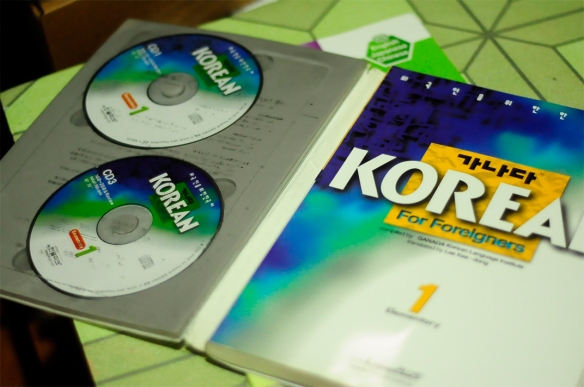 The book includes 4 audio CDs for the dialogues, the exercises, reading, and listening. They used male and female native speakers to enable learners to achieve correct pronunciation and pacing.
The book includes 4 audio CDs for the dialogues, the exercises, reading, and listening. They used male and female native speakers to enable learners to achieve correct pronunciation and pacing.
Every lesson starts with a dialogue to give the learners a grasp on how the words and grammar points are used. There are English translations just below every line so I find it very impractical, since learners might have difficulties in shifting from English to just Korean, since they would occasionally check the meaning in real time. In the newer books, translations can be found on the next page.
Basically, new found words and grammar points from the dialogue can be found first page after the dialogue page. There’s a vocabulary part just above grammar, but I failed in framing the shot >.< Anyway, it just looks like the ‘additional words’ part that can be found below. Grammar is explained at minimum, and the book presents three examples per grammar point. Content and explanation-wise, this book lacks a bit, so it’s hard for self-studying learners.
This is similar with the vocabulary section I was talking about. But instead of words from the dialogue, this section has the words that will be appearing in the following exercises. There are more or less 500 words all throughout the book, enough to be used for sample sentences and for Basic Korean knowledge.
Exercises are basically fill in the blanks, you are given a word and you just pattern it from the sample sentences from every exercise. It is very weak in practicing you in terms of usage, but just the form. If you need more practice to perfectly make use of the grammar and vocabularies, get the complementary Workbook.
Every after 5 lessons, there are review pages where you can practice reading and comprehension, some other times there are puzzles and other gimmicks, and of course a listening exercise. And every after lesson pages, you are presented a page of extra knowledge and random necessities, such as Korean culture, Korean traditional songs, synonyms and antonyms, a map, etc. As for this page, it’s about pronunciation. I saw the advanced books and up to that level they still present a bit of pronunciation rules.
Will I recommend this book for first time learners?
Not anymore. It’s better if you get the newer version since it’s… yeah you got it, NEW. And besides, this book is more of a classroom book rather than a self-study material. There are a lot of textbooks that can be used for both purposes because it is more in contents, visuals and explanations. But looking at the bright side, this book has been published in 2007, 6 years may have a lot of difference but this book still contain a lot of universal information.
Pros:
- The book contains important words and grammar points for beginners.
- It has 4 Korean CDs with Korean native speakers for accurate speed and pronunciation.
- Grammar points are taught in order of importance.
- Verb conjugations at the back.
Cons:
- The book is not updated, get the newer version instead.
- Titles of dialogue are what’s in the table of contents so it’s hard to keep track of grammar points and where can you find them.
- It starts in the formal form, which is not used even for first time Korea travelers.
- Visuals are monochromatic and boring.
Grammar Points (자모):
- -거나
- -겠
- -고
- -고 있다
- -기
- -기 때문에
- -께서
- 누구
- -는/은
- ‘ㄷ’ 불규칙 동사
- -도
- ‘ㄹ’ 불규칙 도사
- -마다
- 몇 –
- 무엇
- -부터 -까지
- 숫자 1 + 2
- -(스)ㅂ니다. -(스)ㅂ니까?
- 시간
- 아니다
- -아/어요
- 안 –
- -았/었-
- 어느
- 어디
- 어떻게
- 언제
- -에
- -에게/한테
- -에게서/한테서
- -에서
- -와/과
- -와/과 같이(함께)
- 우리
- -(으)ㄹ까요?
- -(으)러
- -(으)려고
- -(으)로
- -(으)ㅂ시다
- ‘ㅡ’ 불규칙 동사
- -(으)시
- -(으)십시오
- -을/를
- -이/가
- 이것/저것/그것
- 이 – / 저 – / 그 –
- -(이)나
- -이다
- -전에 / -기 전에
- – 지만
- -지 맙시다
- -지 않다
- -후에 / -(으)ㄴ 후에
Technical facts about the book:
가나다 Ganada Korean for Foreigners | Elementary 1 (초급1)
Copyright 1997
Price: 20,000 Won
ISBN: 978-89-5518-163-0
GANADA is the first three basic consonants, ‘ㄱ, ㄴ, ㄷ’ joined with the vowel ‘ㅏ’ which represents 한글.
I hope this review helps.

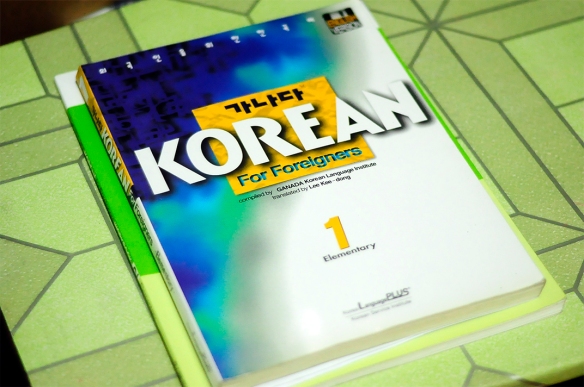
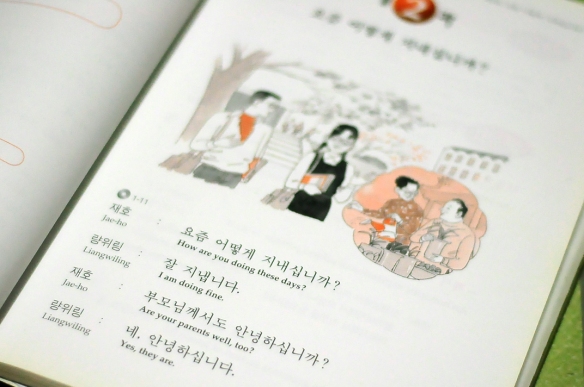
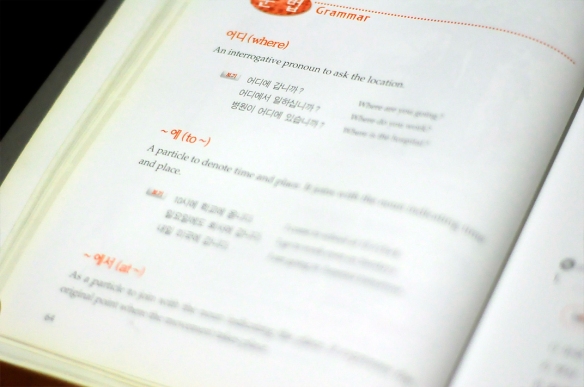
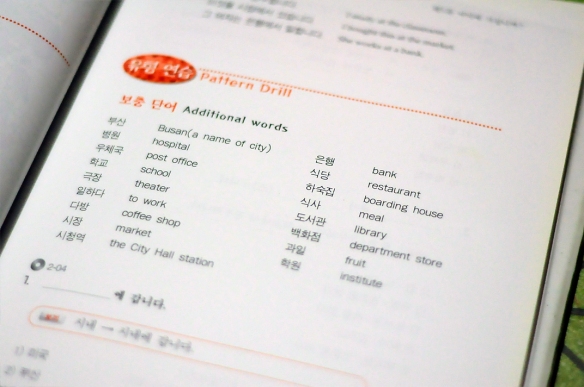
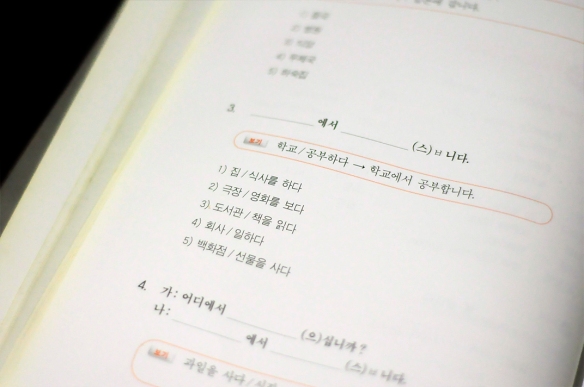
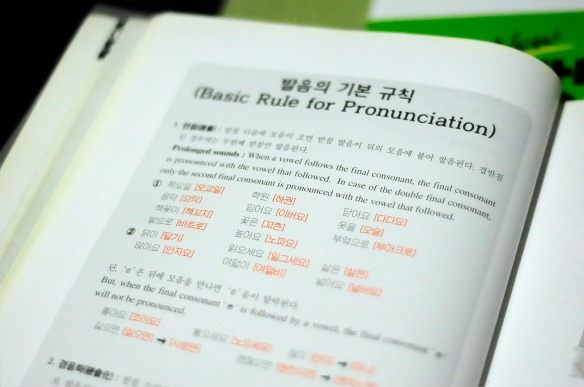
wow! Your review is really interesting. I’m using intermediate and advanced Kanata Korean textbooks and I think that they are a little bit easy in comparison with other textbooks like Yonsei,Ewha
Yes, I believe it’s easier, but it lacks a lot of valuable information, especially these days, learners are quite fast. I will review the newer version some other time 🙂
Thanks for this review! It’s very well written and organized. I was wondering about this series for a while since I haven’t seen it in my bookstore yet and I hate having to judge a book by its cover. I really like how there’s lots of audio material to help grasp pronunciation and intonation. It’s a necessity. NECESSITY. OTL I’m most likely going to buy Yonsei and Ewha textbooks, but I was really curious about what this series had to offer.
Hi, thanks for taking the time to read the review. I’m going to review the newer book maybe this week, so please wait for it before you decide 🙂
Hi! 🙂
Do you have the ripped audio of the 4 CDs? 😦 I lost my 4th CD so I am having a hard time~ T^T (I usually listen to it when I am travelling)
I know I have it somewhere in my harddrive. I’ll check. If not, I’ll see what I can do, I still have the CDs with me 🙂